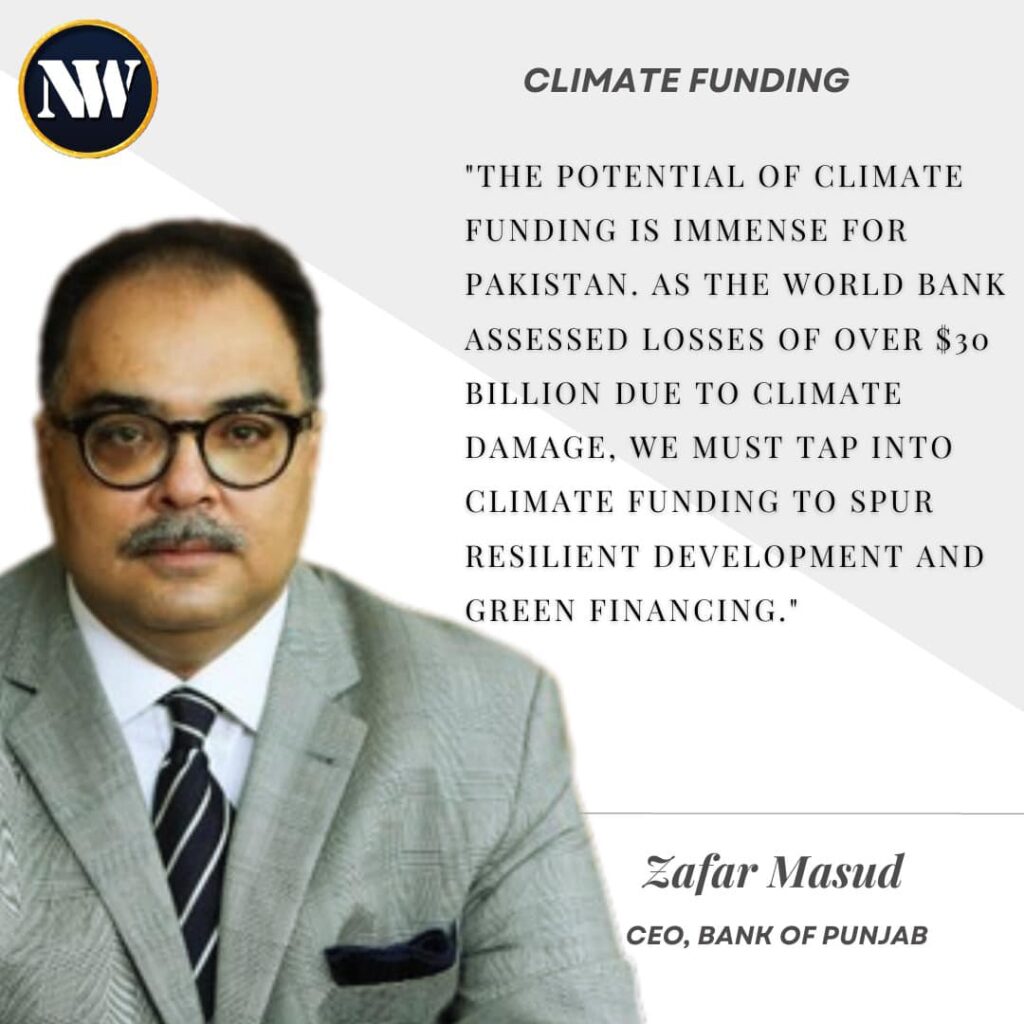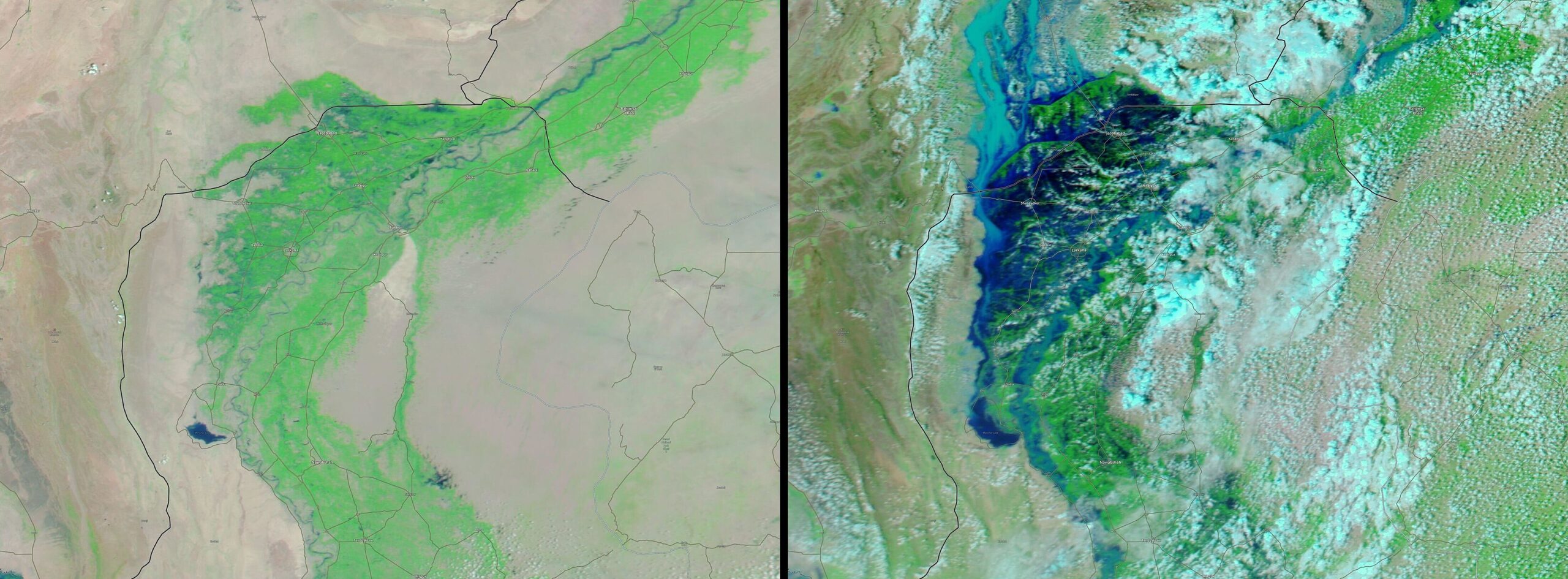Zafar Masud underscored Pakistan’s potential in climate funding, given its vulnerability to climate change, highlighting the importance of accessing such funds for climate-resilient development, green finance, and future progress.

Zafar Masud on Pakistan’s Potential in Climate Funding
The potential of climate funding is immense for Pakistan. s the world bank assessed losses of over $30 billion due to climate damage, we must tap into climate funding to spur resilient development and green financing.
Zafar Masud (President & CEO, BOP)
Source: New Wave Global Facebook Page
Zafar Masud, the CEO and President of the Bank of Punjab, has spoken out on the importance of climate finance for Pakistan. He has argued that climate change is a major threat to the country’s economy and development, and that climate finance is essential to help Pakistan adapt to and mitigate the effects of climate change.
Masud has also highlighted the need for Pakistan to mobilize domestic resources for climate finance. He has argued that the government should provide tax breaks and other incentives to encourage private sector investment in climate-friendly projects. He has also called for the government to work with banks and other financial institutions to develop innovative financing solutions for climate projects.
Masud has also stressed the importance of international cooperation on climate finance. He has argued that developed countries should provide financial assistance to developing countries, like Pakistan, to help them address climate change. He has also called for the international community to work together to develop a global framework for climate finance.
Overall, Zafar Masud is a strong advocate for climate finance for Pakistan. He believes that climate change is a major threat to the country’s economy and development, and that climate finance is essential to help Pakistan adapt to and mitigate the effects of climate change. He has also called for the government, the private sector, and the international community to work together to mobilize resources for climate finance.
Here are some of the specific things that Masud has said about climate funding in Pakistan:
- “Climate change is a major threat to Pakistan’s economy and development. We need to invest heavily in climate adaptation and mitigation measures.”
- “Domestic resources are essential for climate finance. The government should provide tax breaks and other incentives to encourage private sector investment in climate-friendly projects.”
- “Banks and other financial institutions need to develop innovative financing solutions for climate projects.”
- “Developed countries should provide financial assistance to developing countries to help them address climate change.”
- “The international community needs to work together to develop a global framework for climate finance.”
Masud’s views on climate funding are shared by many experts and policymakers. Climate change is a serious threat to Pakistan, and it is clear that the country needs significant financial resources to address this challenge. Domestic resources are important, but international assistance is also essential. The international community needs to work together to develop a sustainable and effective framework for climate finance.
The Recent Flood in Pakistan

In July 2022, Pakistan experienced devastating floods caused by heavy monsoon rains. The floods affected nearly 116 districts across the country, displacing over 30 million people and causing widespread damage to infrastructure and crops.
The floods in Pakistan are a stark reminder of the devastating impact of climate change. The country is particularly vulnerable to climate change due to its location in a floodplain and its reliance on agriculture. The floods have also highlighted the need for better infrastructure and disaster preparedness in Pakistan.
In 2022, Pakistan was in the midst of perhaps the worst ‘natural’ disaster in its history. According to the National Disaster Management Authority (NDMA), over 1,000 people had died, more than 30 million people had been displaced, and nearly a million homes had been partially or completely destroyed. The scale of this disaster was many times greater than that of the 2010 floods, which were riverine floods.
As a result of these unprecedented monsoon rains, nearly 116 districts across Pakistan had been severely affected, and the government had declared 66 districts as ‘calamity hit’. Damage to infrastructure had further aggravated the humanitarian situation, as partial or complete destruction of over 3,000km of roads and 145 bridges had impeded the ability of people to access markets or essential services. Government’s initial estimates of damage to the economy had been around US$ 10bn (3% of GDP). While no further official estimates were out yet, however, various sources had claimed a destruction to the tune of US$ 20-25bn.
The disaster had been caused by a combination of factors, including climate change, poor infrastructure, and deforestation. The heavy rains had caused landslides and flooding, which had washed away bridges, roads, and homes. The disaster had also caused widespread damage to crops and livestock.
The Pakistani government and international community had launched a massive relief effort to help those affected by the disaster. However, the scale of the disaster was immense, and it was clear that it would take many years for Pakistan to recover.